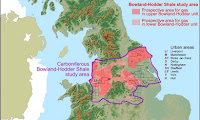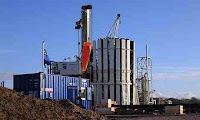The
Bowland Shale and other Carboniferous shale deposits in England,
Wales and Ireland have received considerable interest from
hydrocarbons exploration companies in recent years, due to the high
levels of natural gas held within the deposits, which companies hope
to exploit using hydraulic fracturing (fracking) a controversial
technology which involves blasting the rock with high pressure water,
chemicals and sand in order to fracture the rock and release the gas
trapped within it. This technology has driven a boom in the gas
industry in the US, but has been linked to a number of environmental
problems, including the release of harmful trace elements such as
arsenic and selenium from the shale deposits, which have in some
cases then entered aquifers or other natural water sources. The
organic geochemistry and radionuclide flux of the Bowland Shale have
been studied, but to date no study has been made of the trace element
geochemistry of these deposits, despite the fact that permits to
exploit the gas have been issued, and a moratorium on the practice in
one English county (Lancashire) has been overturned by the UK Government.
In a
paper published in the journal Applied Geochemistry on 12 December
2015, John Parnell and Connor Brolly of the School of Geosciences at
the University of Aberdeen, Sam Spinks, also of the School of
Geosciences at the University of Aberdeen and of the CSIRO Mineral Resources Flagship at the Australian Resources Research Centre, and
Stephen Bowden, also of the School of Geosciences at the University
of Aberdeen, describe the results of a study of the Selenium, arsenic
and molybdenum contents of the Bowland Shale of England and Wales and
related deposits in Ireland, and the implications of this for the
hydraulic fracturing industry and the wider environment.
Selenium
is essential to animals and plants, but at higher levels becomes
toxic. In humans, when consumed at levels higher than about 400 μm
per day, selenium is neurotoxin and a carcinogen and can cause
diabetes. Excess selenium in the environment has been linked to other
fossil fuels, with problems recorded close to coal storage
facilities, coal burning industries and oil refineries. In Ireland
instances of selenium toxicity in farm animals have occurred where
soils directly overlying black shale deposits have had raised levels
of the metal due to leaching, and wells in parts of France have been
abandoned after it was revealed that the water was enriched with
selenium after coming into contact with black shale deposits. Further
more hydraulic fracturing of the Barnett Shale in Texas has been
directly linked to raised levels of selenium in local groundwater.
Incidents of raised selenium in groundwater after hydraulic
fracturing have also been reported in parts of Montana and the
American southeast.
Arsenic
is a more familiar toxin, and is found in many minerals, particularly sulphur compounds. Trace levels of arsenic are again important to animal life, but at higher levels it is extremely toxic, and is a major source of groundwater toxicity in many parts of the world. Raised arsenic levels in
groundwater extracted from wells in Texas has also been reported
following hydraulic fracturing of the Barnett Shale.
Molybdenum
is another metalic element found in a range of minerals. It is essential to the metabolic processes of nitrogen-fixing Bacteria and essential to all multi-cellular life-forms at low levels, but again becomes toxic at higher levels. As with selenium, incidents of molybdenum toxicity
have been recorded in Irish livestock grazing on soils directly
overlying black shale deposits.
Parnell
et al. examined 42 samples of
shale taken from the Bowland and related shale deposits at seventeen
sites, seven in England, one in Wales, one on the Isle of Man, and
eight in Ireland. These were milled and treated with perchloric,
nitric, hydrofluoric and hydrochloric acids to remove as much water
from the samples as possible, then analysed by inductively coupled
plasma-mass spectrometry to determine the trace element levels.
Map
of central British Isles, showing outcrop of Namurian rocks, region
of Ordovician volcanic basement, sampled localities in Bowland Shale
Formation, and localities for Se/As-rich oil residues. A, Altmush; B,
Ballybunion; D, Dunshaughlin; E, Edale; H, Holywell; K, Killadysert;
L, Co. Leitrim (Glenfarne, Thur Mountain); M, Poyllvaaish, Isle of Man;
P, Pendle Hill and Earby; R, Walmsley Bridge; S, Loughshinny; T,
Trough of Bowland; V, Lisdoonvarna; W, Whalley and Wiswell. Parnell
et al. (2015).
The Carboniferous shale deposits of the UK and Ireland were found to
have an average selenium level of 20.5 parts per million, with
younger parts of the deposits having lower levels than older parts.
This compares with average selenium levels in oil shales of about 13
parts per million; notably the Cretaceous black shales of Montana
have average selenium levels of about 10 parts per million and the
Cretaceous black shales of the souheasern United States only about 1
part per million, yet hydraulic fracturing of both has been linked to
unsafe levels of selenium in groundwater.
Molybdenum levels in the shales were also notably high, with levels
ranging from 20 to 70 parts per million, with one exception in the
samples from Ballybunion in County Kerry, where levels reached 155
parts per million. In the case of molybdenum there appeared to be no
correlation between molybdenum levels and the age of the deposits,
though there is a correlation between molybdenum levels and organic
carbon levels; this relationship has previously been recorded in the
Barnett Shale of Texas, but the British and Irish shales show
consistently far higher molybdenum levels than those from Texas.
Arsenic levels were also consistently higher in the British and Irish
shales than in other shales studied, reaching a maximum of 52 parts
per million in samples from Lancashire, with almost all samples
exceeding the 8-9 parts per million typical of the Barnett Shale,
hydraulic fracturing of which has again been linked to dangerously
high arsenic levels in groundwater.
Parnell
et al. strongly
suspect that the high levels of selenium, molybdenum and arsenic in
the Carboniferous black shales of Great Britain and Ireland are
related to the Ordovician volcanic arc which cuts through the centre
of the deposits and which would have been an important source of
water run-off when the deposits were forming. Layers of tuff
(volcanic ash) within the shale beds also suggest that the deposits
may also have been subject to occasional bouts of fresh volcanic
input as they were forming. Volcanic rocks and ash falls are known to
be important sources of trace metals.
The presence of high levels of these elements in the Carboniferous
shales of Britain and Ireland is of great concern if plans to exploit
these shales go ahead, particularly as the elements are present at
much higher levels than they are in American deposits where these
elements have caused environmental problems. In theory a repeat of
any such problems could be avoided with a sufficiently tight
regulatory and monitoring system, but, particularly in the UK, it is
unclear if the political will to implement this exists.
See also...
 The British Geological Survey reports on Shale Gasses in the Bowland-Hodder Unit. Shale gasses have become an economically important source of
hydrocarbons in the early twenty-first century, as other reserves have
run low...
The British Geological Survey reports on Shale Gasses in the Bowland-Hodder Unit. Shale gasses have become an economically important source of
hydrocarbons in the early twenty-first century, as other reserves have
run low... Report recommends Fracking should be allowed to continue in the UK. Fracking, or Hydraulic Fracturing, is a
process by which water, sand and chemicals are forced into buried
sediments in order to shock them into...
Report recommends Fracking should be allowed to continue in the UK. Fracking, or Hydraulic Fracturing, is a
process by which water, sand and chemicals are forced into buried
sediments in order to shock them into... Fracking linked to earthquakes in Lancashire, northeast England. On Wednesday this week (2 November 2011) a report commissioned by petrochemical exploration company Cuadrilla Resources
concluded that...
Fracking linked to earthquakes in Lancashire, northeast England. On Wednesday this week (2 November 2011) a report commissioned by petrochemical exploration company Cuadrilla Resources
concluded that...
Follow Sciency Thoughts on Facebook.

